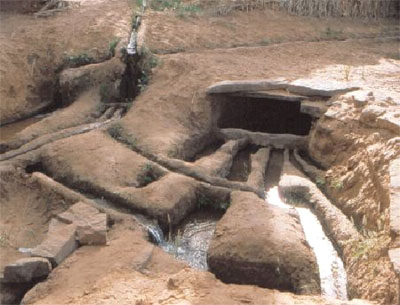The Ouled Said Oasis is in Adrar Province, southwestern Algeria. It is a 25,000ha man-made oasis in the Sahara desert. Deep sources of groundwater are tapped and distributed though canals (fouggera) and shared to individual palm groves for the production of dates, fruit and cereal crops.
The fouggera is an ancient irrigation system common in Algeria, the southwest region of Tunisia, Libya, Morocco, Sicily and Spain. The origins of the fouggera can be traced to the Persian civilization, from where it spread east to the Arab lands and then to North Africa. This irrigation method is well suited to dry areas and moun¬tainous regions, where the yearly average rainfall doesn't exceed 500mm.
The canals link the water spring, usually in the higher part of land, to the dif¬ferent areas to be irrigated in the lower part. Digging of these canals usually starts at the flat lower part of land and moves upwards towards the water source so that the water does not flood and hinder the dig¬ging process. An incline of about 10 % is ensured while digging so that water can run easily afterwards.
Vertical holes linking the underground canal to the sur¬face were dug thus allowing not only the taking out of earth and the necessary light and aeration needed for the excavation work but they also formed an issue or outlet through which the canals can be maintained later. The depth of these wells varies from 20 to 60 m at the top to about 3 to 10 m at its lower part. Con¬tinuous maintenance is requi¬red to keep the canals clean and in good condition. The under¬ground canals have to be cons¬tantly cleared of the remaining wet earth so that water can always flow easily and the water spring in the upper part has to be dee¬pened from time to time in order to maintain a constant amount of water flow.
Sharing the Water Resource
Cultivation on farms is dependent on the quantity of water provided by the fouggeras. Water is¬ equally divided among the dif¬ferent property owners. When the amount of cultivated land increases, new canals are dug.
In addition to being an irri¬gation system for agriculture, this network of wells and underground canals also pro¬vides water for drinking and for daily housekeeping tasks. Peo¬ple living in dry areas would get water either from the surface canals on their farms or from the vertical wells found along the horizontal underground network of canals. In some areas, each indi¬vidual house has its own well, which explains why houses were built all in a row on the same line along the network of the canals.
The canals require constant maintenance and attention to keep from being overtaken by the desert; some of these canals system in are in danger of disappearing. Water no longer runs in the canals which, along with the wells, become completely covered with earth.
Ouled Said Oasis is an important site for migratory birds and includes large areas of archaelogical remains of an original Arab/Muslim architecture of "Ksars" (fortresses) from the 14th century.
Source: Tunisia News, 1996.


